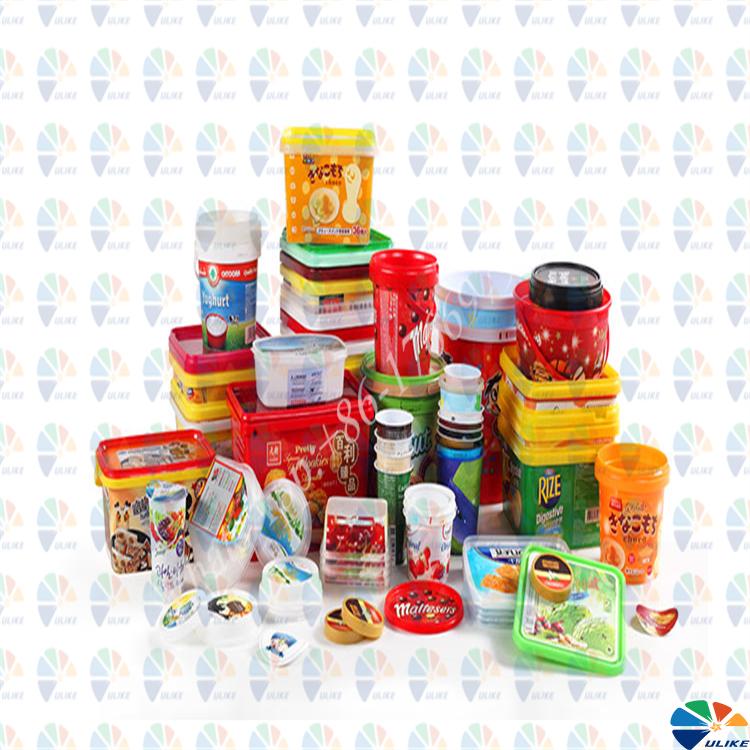New highlights of in-mold labeling
New highlights of in-mold labeling
This packaging method of in-mold labeling is not only closely related to the production process of printing and packaging containers, but it even connects all the links involved in the entire packaging (including label design). Therefore, coordination from all aspects is required to complete an excellent packaging and serve the product. Choosing suitable in-mold label materials is a very important step in the entire in-mold labeling process. Let me show you what are the commonly used in-mold materials~~
1. Economic
in-mold label materials
The price of economic in-mold label materials is relatively cheap, which can well solve the problem of self-adhesive labels warping and falling on some product packaging. Compared with self-adhesive labels, its anti-counterfeiting performance is more advantageous. Low unit price and ultra-high yield rate are the biggest advantages of economic in-mold label materials, especially in these fields, which can solve the problems of self-adhesive labels warping and falling, while ensuring the integrity of the packaging, it can save more costs.
2. Highly reproducible in-mold label materials
Highly reproducible in-mold label materials can achieve perfect display effects, avoid the problems of self-adhesive labels warping, falling, wrinkling, etc., and save costs. Highly reproducible in-mold label materials are smoother and more delicate, and can perfectly reproduce more delicate text, lines and other pattern information. They are suitable for hot stamping, printing special inks, etc., and provide label designers with a variety of design ideas to achieve the diverse expression effects that customers want.
3. Transparent in-mold label materials
Transparent in-mold label materials express the clean and safe characteristics of products with a more excellent appearance. In addition to the obvious effect of no label, if used in conjunction with transparent packaging containers, consumers can see the actual contents, which will be more attractive to consumers. Transparent in-mold labels can intuitively display the color and state of the contents, which is more suitable for expressing the efficacy and characteristics of washing products. At the same time, they can solve the problem of damage to traditional self-adhesive labels during circulation and use, and reduce the overall cost.
4. Double-layer composite in-mold label materials
Double-layer composite in-mold label materials can escort packaging safety. Double-layer composite in-mold label materials can not only effectively solve the problem of static electricity, but also "seal" the printing ink between two layers of film, which can prevent the possibility of human body contact with ink. In addition, the double-layer composite not only increases the bright effect, making the packaging more eye-catching, but also the printing effect is not damaged even if there is friction during transportation, which increases the wear resistance and durability of the packaging
5. Large-area in-mold label materials
Labels are the main tool for conveying product information and attracting consumers' attention. Therefore, on containers of the same volume specifications, the larger the display area of the label, the more information it can carry, which can better enhance the attractiveness of the product.
Paint bucket with large-area in-mold label
But at the same time, the larger the labeling area, the higher the stiffness requirement for the label itself. Especially in the field of lubricating oil products where in-mold labels are good at, these products have a large labeling area. Therefore, in the process of in-mold labeling, the stiffness of the in-mold label becomes a more critical factor in determining the yield rate of packaging containers.

![af]() Afrikaans
Afrikaans![sq]() Albanian
Albanian![am]() Amharic
Amharic![ar]() Arabic
Arabic![fr]() French
French![es]() Spanish
Spanish![ru]() Russian
Russian![de]() German
German![hy]() Armenian
Armenian![it]() Italian
Italian![ja]() Japanese
Japanese![ko]() Korean
Korean![pt]() Portuguese
Portuguese![hi]() Hindi
Hindi![az]() Azerbaijani
Azerbaijani![ro]() Romanian
Romanian![pl]() Polish
Polish![th]() Thai
Thai![el]() Greek
Greek![eu]() Basque
Basque![en]() English
English![zh-CN]() Chinese (Simplified)
Chinese (Simplified)![zh-TW]() Chinese (Traditional)
Chinese (Traditional)![be]() Belarusian
Belarusian![bn]() Bengali
Bengali![bs]() Bosnian
Bosnian![bg]() Bulgarian
Bulgarian![ca]() Catalan
Catalan![ceb]() Cebuano
Cebuano![ny]() Chichewa
Chichewa![co]() Corsican
Corsican![hr]() Croatian
Croatian![cs]() Czech
Czech![da]() Danish
Danish![nl]() Dutch
Dutch![eo]() Esperanto
Esperanto![et]() Estonian
Estonian![tl]() Filipino
Filipino![fi]() Finnish
Finnish![fy]() Frisian
Frisian![gl]() Galician
Galician![ka]() Georgian
Georgian![gu]() Gujarati
Gujarati![ht]() Haitian Creole
Haitian Creole![ha]() Hausa
Hausa![haw]() Hawaiian
Hawaiian![iw]() Hebrew
Hebrew![hmn]() Hmong
Hmong![hu]() Hungarian
Hungarian![is]() Icelandic
Icelandic![ig]() Igbo
Igbo![id]() Indonesian
Indonesian![ga]() Irish
Irish![jw]() Javanese
Javanese![kn]() Kannada
Kannada![kk]() Kazakh
Kazakh![km]() Khmer
Khmer![ku]() Kurdish (Kurmanji)
Kurdish (Kurmanji)![ky]() Kyrgyz
Kyrgyz![lo]() Lao
Lao![la]() Latin
Latin![lv]() Latvian
Latvian![lt]() Lithuanian
Lithuanian![lb]() Luxembourgish
Luxembourgish![mk]() Macedonian
Macedonian![mg]() Malagasy
Malagasy![ms]() Malay
Malay![ml]() Malayalam
Malayalam![mt]() Maltese
Maltese![mi]() Maori
Maori![mr]() Marathi
Marathi![mn]() Mongolian
Mongolian![my]() Myanmar (Burmese)
Myanmar (Burmese)![ne]() Nepali
Nepali![no]() Norwegian
Norwegian![ps]() Pashto
Pashto![fa]() Persian
Persian![pa]() Punjabi
Punjabi![sm]() Samoan
Samoan![gd]() Scottish Gaelic
Scottish Gaelic![sr]() Serbian
Serbian![st]() Sesotho
Sesotho![sn]() Shona
Shona![sd]() Sindhi
Sindhi![si]() Sinhala
Sinhala![sk]() Slovak
Slovak![sl]() Slovenian
Slovenian![so]() Somali
Somali![su]() Sudanese
Sudanese![sw]() Swahili
Swahili![sv]() Swedish
Swedish![tg]() Tajik
Tajik![ta]() Tamil
Tamil![te]() Telugu
Telugu![tr]() Turkish
Turkish![uk]() Ukrainian
Ukrainian![ur]() Urdu
Urdu![uz]() Uzbek
Uzbek![vi]() Vietnamese
Vietnamese![cy]() Welsh
Welsh![xh]() Xhosa
Xhosa![yi]() Yiddish
Yiddish![yo]() Yoruba
Yoruba![zu]() Zulu
Zulu


